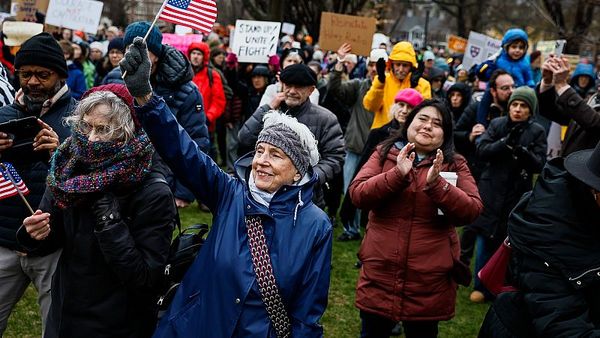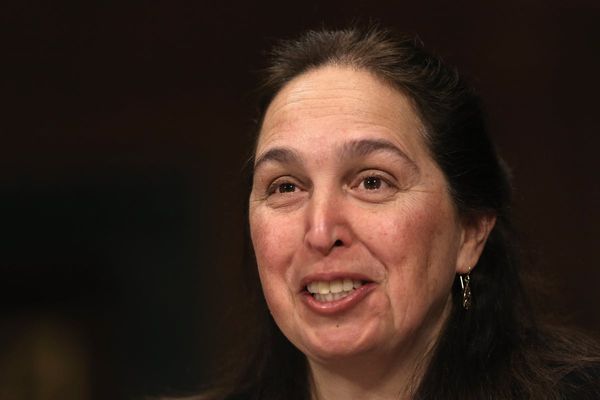
- Treasury Secretary Scott Bessent denied that chaos in the bond market over the deleveraging of so-called basis trades forced President Trump into putting his global trade tariffs on pause for 90 days. Rather, Bessent said, this was Trump’s plan all along.
Treasury Secretary Scott Bessent denied Wednesday that bond market volatility had forced the president into putting a 90-day pause on most trade tariffs.
Following President Trump’s announcement that most of the tariffs he’d planned for U.S. trade partners would now not go into effect pending further negotiations, Bessent was asked by reporters at the White House whether a shocking rise in bond yields that sparked fears about a liquidity crisis and questions about whether Treasuries were losing their safe-haven status had pushed Trump into the partial retreat.
“This was driven by the president’s strategy,” the Treasury secretary said. “He and I had a long talk on Sunday, and this was his strategy all along.”
Stocks jumped after Trump announced the 90-day pause, in which most countries (except China) will be moved back to a baseline 10% tax on imports.
“This was the news we and everyone on the Street [were] waiting for as the pressure on Trump took on a life of its own,” Dan Ives and Sam Brandeis of Wedbush Securities wrote in a note Wednesday afternoon. “And the eye-popping rise of the 10-year yield was ultimately too much to hold his line on the self-inflicted Armageddon tariff unleashed at midnight. Now we would expect massive negotiations across the board over the coming months including China being front and center as the biggest wild card.”
Earlier, Bessent claimed that the bond market would calm down as highly leveraged bond trades unwound. He also noted that this type of deleveraging was normal and expected.
A select group of hedge funds profit handsomely from the so-called basis trade, which involves heavy borrowing to take advantage of tiny price discrepancies between Treasuries and futures linked to those bonds. Typically, this helps keep money markets humming. When the $1 trillion trade unwinds, however, yields surge as the market struggles to absorb a massive increase in the supply of Treasuries.
In an interview with Fox Business, Bessent said he’s seen a similar story play out many times during his hedge fund career.
“There’s one of these deleveraging convulsions that’s going on right now in the markets,” he said. “It’s in the fixed-income market. There are some very large leverage players who are experiencing losses that are having to deleverage.”
Investors initially piled into Treasuries last week as the stock market plunged after President Donald Trump unveiled sweeping “reciprocal tariffs,” which went into effect Wednesday morning. Early Monday, the yield on the benchmark 10-year Treasury note fell below 4% for the first time since October, down from about 4.8% in early January. A fixed-income selloff soon followed, however, and the 10-year yield—which rises as the price of the bond falls—surged above 4.5% Wednesday morning before retreating near the 4.4% mark as a successful Treasury auction eased concerns about demand for U.S. debt, per CNBC.
Bessent addressed concerns about chaos in fixed income by saying, “I believe that there is nothing systemic about this. I think that it is an uncomfortable but normal deleveraging that’s going on in the bond market.”
Basis trade could impact mortgages, car loans
Market watchers have cited many possible reasons for the confusing selloff in bonds. As trade policy uncertainty reigns, investors could be desperate to simply hold cash, similar to the onset of the COVID-19 pandemic. Traders are struggling to price in how the Federal Reserve could react if a global trade war induces dreaded stagflation—rising inflation coupled with slowing growth. There’s a chance China and other foreign holders of U.S. debt are flooding the market with Treasuries to retaliate against Trump’s tariffs.
Evaluating all those explanations relies on circumstantial evidence of what’s going in markets, Torsten Sløk, chief economist at private equity giant Apollo, told Fortune on Tuesday.
Still, he thinks the basis trade is a likely culprit. For hedge funds to profit significantly on the tiny arbitrage opportunity, they need to do a lot of borrowing. According to the Financial Times, they might take as much as 50- to 100-times leverage, meaning $10 million in capital, for example, could support $1 billion of Treasury purchases.
During periods of extreme volatility, however, that leaves hedge funds vulnerable to margin calls from broker-dealers, Sløk noted.
“It is very, very unusual that you have long-term interest rates going up when the stock market is going down,” he said. “That’s telling me that there [are] some distressed, forced sellers out there.”
This is a concern, Sløk said, because long-term Treasury yields, particularly the 10-year, are the basis for mortgage rates, car loans, and other types of common borrowing costs throughout the economy.
“You don’t want long-term rates to go up for non-economic reasons,” he said.
To prevent that during the early days of the pandemic, the Federal Reserve had to buy $1.6 trillion in Treasuries over the course of several weeks. The central bank also temporarily loosened bank capital requirements instituted after the Global Financial Crisis. Exempting Treasuries and bank reserves from the so-called supplementary leverage ratio enabled lenders to buy more U.S. debt.
While insisting the market will steady as hedge funds de-risk, Bessent indicated Wednesday he wanted to make that change permanent as part of a broader deregulatory push.
Update: This story was updated with a longer version of a quote from Treasury Secretary Scott Bessent after President Donald Trump's announcement of a 90-day pause on reciprocal tariffs, as well as commentary from a note written by Dan Ives and Sam Brandeis of Wedbush Securities.







